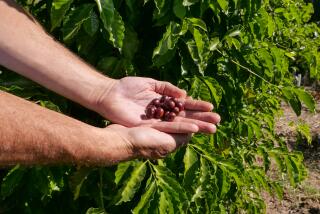Indio Still Inspired by ‘Arabian Nights’ : Home front: Despite the war, date festival organizers are keeping the Middle Eastern theme.
- Share via
The glare from the desert sand could blind a camel. Exotic date palms thrive in clusters, each appearing like an oasis in the heat, a shelter from the unknowns of the barren desert. In what looks like a marketplace, minarets and stone arches decorate the skyline.
There are buildings with Moorish architecture, towns named Mecca and Oasis, streets named Arabia and Deglet Noor, city signs written in Arabic script, and high school teams called the Arabs and the Rajahs.
This could be the Persian Gulf, but there are no troops positioned here, no Scuds or Patriot missiles.
This is Indio in California’s Coachella Valley, a region that replicates the Middle East in one other way: Both are major date-producing areas. Coachella Valley is the biggest supplier in the United States, and the Middle East is the biggest supplier in the world.
But on the eve of the valley’s National Date Festival--an annual celebration of the industry that ties the two regions--festival organizers prefer to separate the two as war rages in the Persian Gulf.
“We always hope it doesn’t scare anybody away,” says Craig Manning, executive director of the festival, which starts Friday and runs through Feb. 24 in Indio. “We’re not involved in the Arab cause, it’s just kind of unusual timing.
“There haven’t been any calls asking ‘Why are you holding the date festival?’ ” Manning says, “but we’ve wondered, are there a significant amount of people who wouldn’t come because they connect us with Saddam Hussein? But maybe 99% of the people don’t think that.”
The comparisons, however, seem inevitable, especially in light of the festival’s “Arabian Nights” theme, which includes camel and ostrich races, and Monday’s 10 a.m. Arabian Nights Parade through downtown Indio.
So the fair’s board is emphasizing other aspects this year: the carnival rides; home arts and crafts; off-track betting; junior livestock competitions; fine art, photography and agricultural exhibits; the performers (including B.J. Thomas, Sha Na Na), and a new, $4-million exhibit building.
Admission is still free for people wearing “Arabian Nights” costumes.
“We don’t pretend to be authentic,” says Jerry Taylor, a fair board member and a 40-year resident of the Coachella Valley. “It’s fantasy. We want dazzle and glitter.”
And that the festival has at its nightly Arabian Nights pageant, a colorful tradition since 1948, with bangled costumes, a cast of nearly 100 locals and lots of romance and flair. Even the fairgrounds’ stage was built by a Hollywood set designer.
And because the war has created an interest in Arab culture, there’s always the chance, Manning says, that curiosity could actually bring more people out to the fair, which draws about 275,000 people each year.
“A couple years ago, there were a couple of Middle Eastern gals here,” Manning recalls. “They were overjoyed that (the fair) showed off a bit of their culture. They’d never seen anything like it here.”
If this year’s attendance is down, Manning said, the recession could be to blame, not fear.
The date industry took root in California in the early 1900s, when it was discovered date palms would grow in the hot, sandy Coachella Valley, which is similar in climate and soil to the Middle East.
The Coachella Valley is “the date capital of the U.S., by far the major grower,” said John Schrader, supervising agricultural biologist for the Riverside County Agricultural Commissioner Office. The valley produces 95% of the dates grown in the United States. Still, that 40 million pounds a year doesn’t put much of a dent in the 2 million tons generated in the Middle East, which is the world’s biggest supplier.
The date festival began in 1921 to celebrate the harvest. It has grown in size and scope partly because the Coachella Valley is growing. The 1990 census showed Riverside County’s population increased 76% over the last decade.
Many date growers are eager to participate in the festival, boxing dates in fancy arrangements or exhibits for display in the Taj Mahal, where the agricultural exhibits are displayed. A 13-minute video describes how dates are grown and processed, the industry’s origins in the Coachella Valley and its connections to the Middle East.
Ben Laflin’s father was one of the original growers; he started a crop in 1912. Laflin took over the family business and is the owner-operator--along with his wife, Pat--of Oasis Date Gardens in Thermal. “The first time I met Ben, I thought he said he was from India,” Pat Laflin recalls with a chuckle. “I’d never heard of Indio.”
Today, Ben Laflin handles the date crop and Pat Laflin manages the business operation from an upstairs office in the Oasis Date store. Tourists stop here and at other roadside shops for everything from nut- and peanut butter-filled deglet noors (the most common type of date sold in the United States) to chocolate-covered dates, and almost always for the date shakes, a fair favorite.
Theirs is one of the few operations that does the growing, packaging, retailing and wholesaling of dates in an industry subject to heavy sanitary regulations.
Unlike most dates abroad, U.S. dates are required by the U.S. Department of Agriculture to be free from pests, dirt and disease, says Schrader. Growers here have shared harvesting techniques with Egypt, Saudi Arabia, Israel and other countries in their long-fought battle against diseases and pests.
Since the war broke out, Iraq has had other problems to worry about. And no one knows what effect the war will have on that country’s date market until the fighting ends.
Basra, the second-largest city in Iraq and a chief date center, has been under heavy bombardment by the allied forces. The date is known to be a tough fruit, but probably not that tough.
“Iraq is one of the principal growers, and the war is definitely having an effect,” Laflin says. “They’re not exporting them. . . . Who knows at this stage of the game.”
It is still unknown if an embargo on Iraqi goods has boosted the date industry here, as some speculated early in the war. There hasn’t been a noticeable difference, although some growers, including the Laflins, have heard from date brokers looking for suppliers.
Iraq was “already into the harvest when they took Kuwait,” says John Carpenter, a plant pathologist from the Coachella Valley who travels to the Middle East “once or twice a year” and, before his retirement, worked for the USDA. “By the time the bombing started, they should’ve been through with the harvest.”
And it’s possible that even now, Carpenter says, soldiers in the bunkers in Iraq and Kuwait are supplementing their diet with dates.
The National Date Festival, Friday through Feb. 24 in Indio from 10 a.m.-10 p.m. Camel and ostrich racing 1 p.m. daily; second race at 3:30 p.m. on weekends and Presidents Day. Admission is $5, free if wearing full “Arabian Nights” costumes; seniors 62 and older , $4; children 5-11, $3; under 5 free. For information, call (619) 342-8247.
DATES: FACTS AND FIGURES The Middle East dominates the market, supplying about 98% of the world’s dates.
California’s Coachella Valley, a 2 1/2-hour drive east of Los Angeles, produces 95% of the dates grown in the United States.
The average date tree takes about 10 years to mature, then produces about 200 pounds of dates each season.
In the date world, the fragile medjool date is the crown jewel.
Dates are tough and can be kept in cold storage for a couple of years; dried dates will keep for a year or more.
Dates are a staple in the Middle Eastern diet. There, people eat anywhere from 10 to 50 pounds of dates per person per year; Americans eat about 3 ounces per person per year.
More to Read
Sign up for The Wild
We’ll help you find the best places to hike, bike and run, as well as the perfect silent spots for meditation and yoga.
You may occasionally receive promotional content from the Los Angeles Times.






